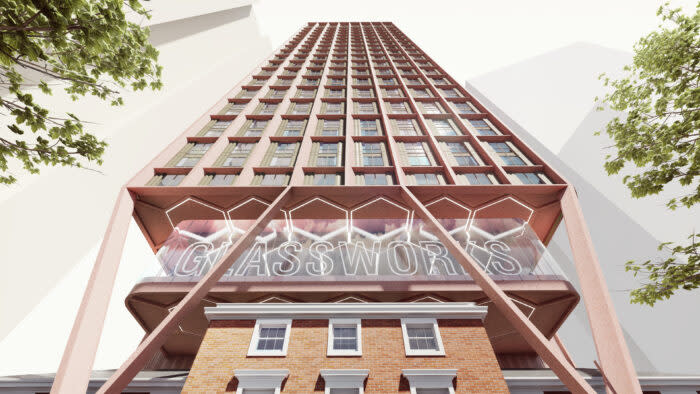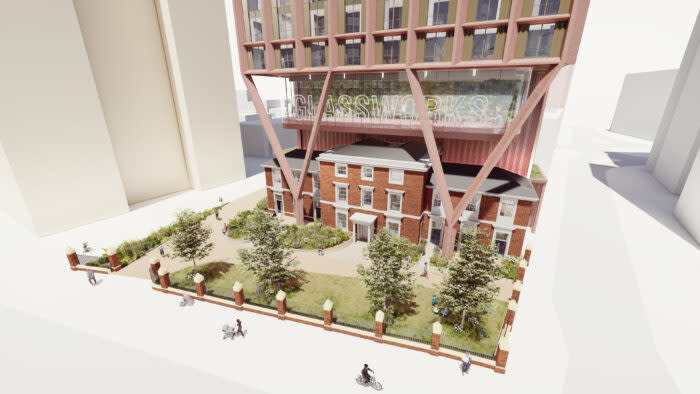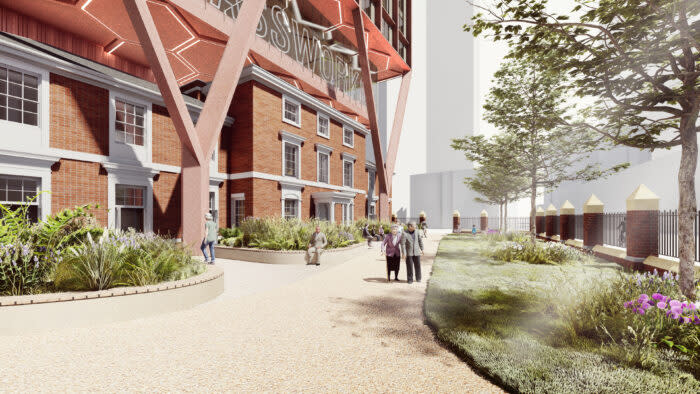Anger at plan to build 42-storey tower over historic building

A plan to build a 42-storey apartment block on top of a Grade II listed building in Birmingham has been described as “outrageous” by a local conservation group.
Historic Buildings & Places (HB&P) has slammed proposals to erect a 133.5 metre (438ft) tower above a former hospital site which cannot legally be demolished. According to the planning application submitted by HJB Investments last Monday, a new residential tower comprising 300 flats will be built.
The tower will be supported by a giant structure, raised above the original building, known as Islington Villa, while maintaining its historical features. HJB said the majority of the flats in the proposed tower would be rented out, and the top of the tower would also feature a viewing platform called Glassworks.
However, HB&P has raised concerns about the potential development and has called upon residents to object to it, stating that it would set a dangerous precedent for preserving listed buildings in the city. It wrote on X, formerly Twitter: “Please help us and object to this outrageous scheme to build a 42-storey tower over a Grade II building in #Birmingham.”

HB&P added in a statement to Yahoo News: “Whilst HB&P welcomes the repair of this grade II listed former hospital building, as with any site involving a listed building, it is imperative that a conservation led approach is adopted.
“There is generally no issue with the development of tall buildings in Birmingham per se, however, the tower entirely changes the way the listed building is experienced and its history is inferred.
“The tower and columns intrude on the sense of space around the building, and completely overwhelms and diminishes its presence within the streetscape. This physically and visually harms its setting and significance and is contrary to the legislative, national or local policy requirements that are designed to protect and conserve our shared heritage for future generations to enjoy.
“The city council must not establish a precedent for the construction of rafted/cantilevered buildings over listed buildings.”
Plans are an 'abomination'
The conservation group's post on X has sparked a conversation among locals and heritage enthusiasts, with many expressing their support for the group's stance against the development and others saying they are in favour of the plans.
Some X users backed HB&P and described the plans as “hideous” and an “abomination”. Another person thanked the heritage group for protecting the "historic" space.
However, others supported the new building and were pleased with the new residential homes. An X user wrote: “300 new homes in central Birmingham? Sounds like a very worthwhile project.”
Another added: “An utterly mediocre building that is lucky that it is being preserved. I am very glad to see the new thing coming up. You can't preserve cities in amber.”
The plans were drawn up by design and development consultant Marrons on behalf of HJB Investments. Marrons planning director Charlotte El Hakiem said: “Broad Street is undergoing a period of intense regeneration, with the overriding vision of creating a vibrant residential neighbourhood, so we are extremely pleased to unveil plans to transform a beautiful Georgian-style building on under-utilised brownfield land.
“The proposal takes a distinctive and innovative approach that allows for the retention and careful repurposing of a Grade II listed building to bring it back into public use, while simultaneously creating a striking 42-storey landmark tower that contains much-needed housing to accommodate the city’s ever-growing population.”

Islington Villa heritage site
Islington Villa was built in the early 19th century and was from 1815 owned by Rice Harris, who helped establish the Islington Glassworks the following year.
The location at 80 Broad Street became the new home of the Birmingham Lying-in Hospital and Dispensary for the Diseases of Women and Children for Birmingham and the West Midlands Counties in 1842. By 1955 it was renamed the Royal Orthopaedic Hospital.
Over the years, it has served various purposes, including as a bar, restaurant, and nightclub, but it was closed down in 2020. Since then, the building has remained vacant and has gradually fallen into a state of disrepair.
The local community has expressed concern about the fate of the historic building, with some calling for its restoration to preserve its rich history and architectural significance.


